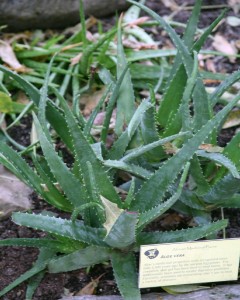Aloe (Aloe vera ) is an important and traditional medicinal plant belonging to the family Liliaceae. It is indigenous to Africa and Mediterranean countries. The species does not have any naturally occurring populations, although closely related aloes do occur in northern Africa. However,It is reported to grow wild on islands of Cyprus, Malta, Sicily, Carary cape, Cape Verde and arid tracts of India. This is a hardy perennial tropical plant that can be cultivated in drought areas. But its potential is yet to be exploited. Aloe, despite being identified as ‘a new plant resource with the most promising prospects in the world’, remains a disregarded plant. It is scattered in the wild, along the coast of southern India. China, U.S.A., Mexico, Australia and some of the Latin American countries are the major producers and exporters of aloe products. These countries are exploiting the plant potential with the growing cosmetic and neutraceutical market.

The species is frequently cited as being used in herbal medicine since the beginning of the first century AD. Extracts from A. vera are widely used in the cosmetics and alternative medicine industries, being marketed as variously having rejuvenating, healing or soothing properties. There is, however, little scientific evidence of the effectiveness or safety of A. vera extracts for either cosmetic or medicinal purposes, and what positive evidence is available is frequently contradicted by other studies. Medical uses of aloe vera are being investigated as well. Aloe can substitute synthetic ingredient used in cosmetic industry very competitively and is finding increasing use in the ever growing consumer product segment.
Introduction
Common Names: Aloe vera, Aloe, Lily of the desert, Burn plant, Elephant’s gall
Latin Names: Aloe vera, Aloe barbadensis
Aloe vera’s use can be traced back 6,000 years to early Egypt, where the plant was depicted on stone carvings. Known as the “plant of immortality,” aloe was presented as a burial gift to deceased pharaohs. Native to Northern Africa, Aloe vera (syn. A. barbadensis Mill., A. vulgaris Lam.) is a stemless or very short-stemmed succulent plant growing to 80–100 cm tall, spreading by offsets and root sprouts. The leaves are lanceolate, thick and fleshy, green to grey-green, with a serrated margin. The flowers are produced on a spike up to 90 cm tall, each flower pendulous, with a yellow tubular corolla 2–3 cm long. Clinical evealuations have revealed that the pharmacological active ingredients are concentrated in both the gel and rind of the aloe vera leaves. These active ingredients have been shown to have analgesic and anti-inflammatory effects.
Description
Aloe vera is a stemless or very short-stemmed succulent plant growing to 60–100 cm (24–39 in) tall, spreading by offsets. The leaves are thick and fleshy, green to grey-green, with some varieties showing white flecks on the upper and lower stem surfaces. The margin of the leaf is serrated and has small white teeth. The flowers are produced in summer on a spike up to 90 cm (35 in) tall, each flower being pendulous, with a yellow tubular corolla 2–3 cm (0.8–1.2 in) long. Like other Aloe species, Aloe vera forms arbuscular mycorrhiza, a symbiosis that allows the plant better access to mineral nutrients in soil.
Taxonomy and etymology
The species has a number of synonyms: A. barbadensis Mill., Aloe indica Royle, Aloe perfoliata L. var. vera and A. vulgaris Lam. Common names include Chinese Aloe, Indian Aloe, True Aloe, Barbados Aloe, Burn Aloe, First Aid Plant. The species epithet vera means “true” or “genuine”. Some literature identifies the white spotted form of Aloe vera as Aloe vera var. chinensis; however, the species varies widely with regard to leaf spots and it has been suggested that the spotted form of Aloe vera may be conspecific with A. massawana.
Techniques based on DNA comparison suggest that Aloe vera is relatively closely related to Aloe perryi, a species that is endemic to Yemen. Similar techniques, using chloroplast DNA sequence comparison and ISSR profiling have also suggested that Aloe vera is closely related to Aloe forbesii, Aloe inermis, Aloe scobinifolia, Aloe sinkatana, and Aloe striata. With the exception of the South African species A. striata, these Aloe species are native to Socotra (Yemen), Somalia, and Sudan. The lack of obvious natural populations of the species have led some authors to suggest that Aloe vera may be of hybrid origin.
Distribution
The natural range of Aloe vera is unclear, as the species has been widely cultivated throughout the world. Naturalised stands of the species occur in the southern half of the Arabian peninsula, through North Africa (Morocco, Mauritania, Egypt) as well as Sudan and neighbouring countries, along with the Canary, Cape Verde, and Madeira Islands. This distribution is somewhat similar to the one of Euphorbia balsamifera, Pistacia atlantica, and a few others, suggesting that a dry sclerophyl forest once covered large areas, but has been dramatically reduced due to desertification in the Sahara, leaving these few patches isolated. Several closely related (or sometimes identical) species can be found on the two extreme sides of the Sahara: Dragon trees (Dracaena) and Aeonium being two of the most representative examples.
The species was introduced to China and various parts of southern Europe in the 17th century. The species is widely naturalised elsewhere, occurring in temperate and tropical regions of Australia, Barbados, Belize, Nigeria, Paraguay and the United States It has been suggested that the actual species’ distribution is the result of human cultivation.
Cultivation
Aloe vera has been widely grown as an ornamental plant. The species is popular with modern gardeners as a putatively medicinal plant and due to its interesting flowers, form, and succulence. This succulence enables the species to survive in areas of low natural rainfall, making it ideal for rockeries and other low-water use gardens. The species is hardy in zones 8–11, although it is
intolerant of very heavy frost or snow. The species is relatively resistant to most insect pests, though spider mites, mealy bugs, scale insects, and aphid species may cause a decline in plant health. In pots, the species requires well-drained sandy potting soil and bright sunny conditions; however, aloe plants can burn under too much sun or shrivel when the pot does not drain the rain. The use of a good-quality commercial propagation mix or pre-packaged “cacti and succulent mix” is recommended, as they allow good drainage. Terracotta pots are preferable as they are porous. Potted plants should be allowed to completely dry prior to re-watering. When potted aloes become crowded with “pups” growing from the sides of the “mother plant,” they should be divided and re-potted to allow room for further growth and help prevent pest infestations. During winter, Aloe vera may become dormant, during which little moisture is required. In areas that receive frost or snow, the species is best kept indoors or in heated glasshouses. Large scale agricultural production of Aloe vera is undertaken in Australia, Bangladesh, Cuba, the Dominican Republic, China, Mexico,India, Jamaica, Kenya, Tanzania and South Africa, along with the USA to supply the cosmetics industry with Aloe vera gel.
Soils
The plant can be grown in a variety of soils ranging from sandy coastal soils to loamy soils of plains. It is sensitive to water logged conditions. The crop also comes up well in light soils. It can tolerate higher pH and high Na and K salts. Growth is faster under medium fertile, heavy soils such as black cotton soils. In well drained, loam to coarse sandy loam in a pH range up to 8.5, it grows well with higher foliage.
Climate
Aloe has wide adaptability and can grow in various climatic conditions. It can be seen growing equally good in warm humid or dry climate. However, it is intolerant to extreme cool conditions. The plant flourishes well on dry sandy soils at localities with lower annual rainfall of 50 to 300mm. It needs protection against frost and low winter temperature.
Aloe Vera Varieties
Commercially important sub-species are Aloe barbedensis, A. chinensis, A. perfoliata, A. vulgaris, A indica, A. littoralis and A. abyssinica. National Botanical and Plant Genetic Resource, ICAR, has released varieties like IC111271, IC111269, IC111280 etc. Central Institute of Medicinal and Aromatic Plants, Lucknow, has also released the variety AL-1 for cultivation.
Propagation
It is generally propagated by root suckers or rhizome cuttings. For this purpose, medium sized root suckers are chosen and carefully dug out without damaging the parent plant at the base and directly planted in the main field.
It can also be propagated through rhizome cuttings. In this case, after the harvest of the crop, the underground rhizome is also dug out and made in 5-6 cm length cuttings which should have a minimum of 2-3 nodes on them. It is rooted in specially prepared sand beds or containers and after starting sprouting, it is ready for transplanting. On an average, about 36500 suckers are required for a nursery of 1 ha size (14550 for 1 acre nursery).
Spacing and plant population
Normally a spacing of 40cm x 45cm or 60cm x 30cm is followed. This accommodates about 55000 plants per hectare.
Land preparation and planting
The land is ploughed and cross ploughed thoroughly. Farm yard manure is added @ 15 t/ha during the last ploughing. Ridges and furrows are formed at 45 or 60cm apart. The plot may be irrigated if necessary. The suckers are planted at 40 or 30cm apart, maintaining the spacing suggested.
Manures and fertilizers
The crop responds well to the application of farm yard manure and compost. In the first year of plantation, FYM @15 t/ha is applied during the land preparation. During the subsequent years, the same dose of FYM is applied every year. Besides 50 :50:50 kg/ha of N:P:K is applied as basal dose.
Irrigation
Aloe can be successfully cultivated both under irrigated and rainfed conditions. Provision of irrigation immediately after planting and during summer season will ensure good yields. However, the plants are sensitive to water logged conditions.
Plant protection
Aloe is known to be infected by fungus causing leafspot disease. This effects yield and quality of the gel adversely. The disease can be controlled by spraying recommended fungicides.
Interculture
In order to facilitate healthy soil atmosphere, soil works like spading, earthing up, etc. are required in aloe plantation. Weeding at regular intervals are some important intercultural operations.
Harvest
The thick fleshy leaves are ready for harvest from the second year after planting. Normally, three harvests are taken in a year by removing three to four leaves per plant. Harvesting is labour intensive.
It is carried out in the morning and / or evening. The leaves will regenerate from the scar and thus the crop can be harvested up to 5 years after planting. Apart from leaves, the side suckers, which can be used as planting material, can also be sold.
Yield
Yield may be as high as 50 – 55 tonnes of thick fleshy leaves from one hectare plantation. However, a conservative yield of about 40 t/ha may be considered for working out day viability of bankable schemes. Suckers from about 55-60% of the plants could be sold out annually.
Post harvest management
Care must be taken in preparing the leafy plant material for drying or distillation. Freshly harvested plant are generally allowed to wilt and loose moisture in the field before transporting, although some volatiles are lost. Wilting is noticed normally within 24 to 72 hours. But the plant should be kept dry and cool to prevent fermentation or mould growth. A concrete floor under shade can be used. The best oil is in the top leaves.




Where can i buy plantlets or seedlings for my plantation propagation amd business ?